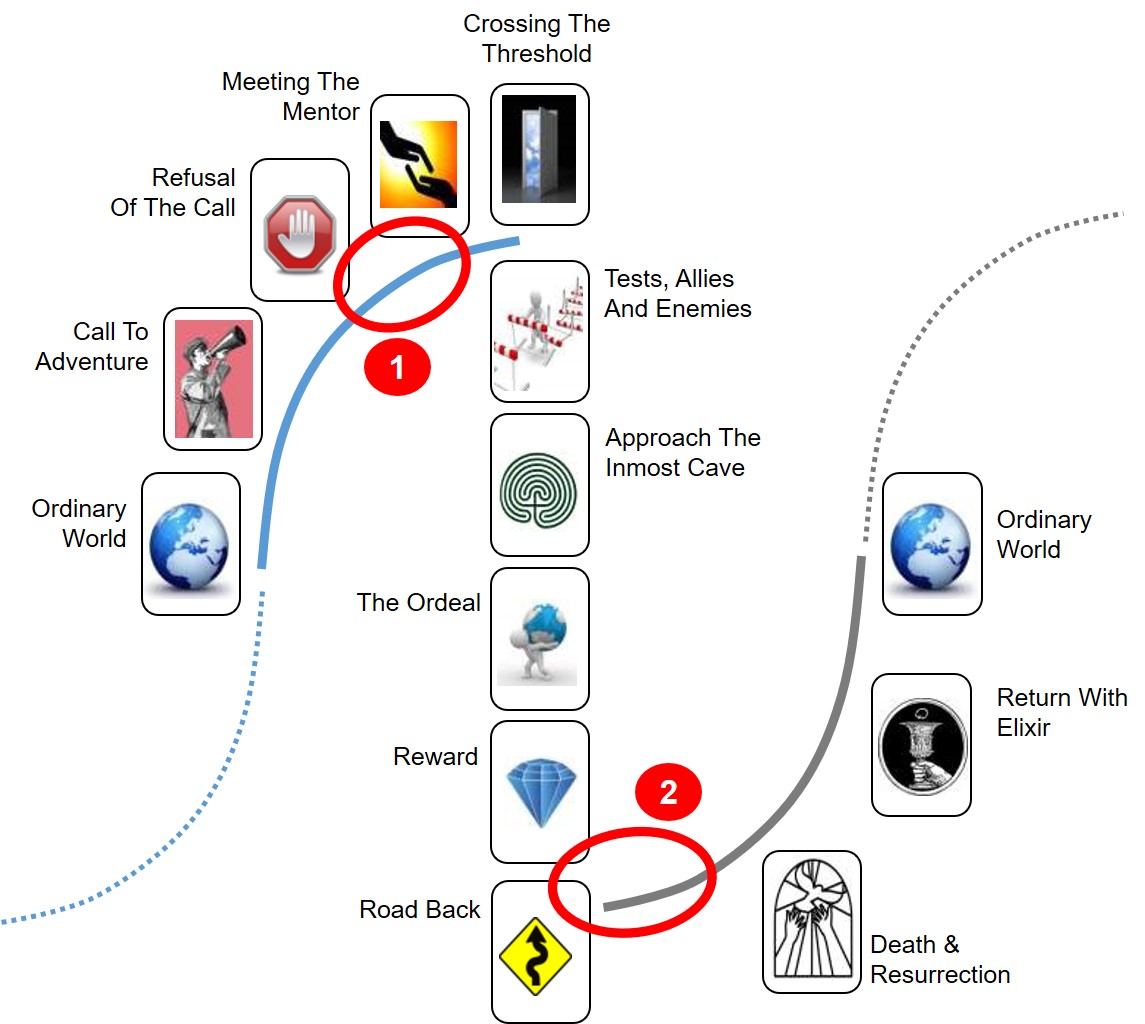
I’ve long been a fan of Joseph Campbell’s Hero’s Journey model as a means of explaining the dynamics of discontinuous change. We typically use the model in an innovation context, but we’ve also had some of the best opportunities to quiz people about it when we’ve been using it to help explain and explore some of the difficulties of organisational change. ‘Where do we think we are on the story?’ is the typical starter question. The answers are many and varied, but in the last couple of years a couple of recurrent themes have begun to appear. Two quite literally recurrent themes. Teams getting stuck in seemingly never-ending loops.
The first one is what I’ve come to think of as the ‘Big Five Consulting Company Dream Cycle’. The dream being their dream of perpetual fees without having to do any meaningful work. As opposed to the client’s dream of meaningful change without expensive bullshit artists watching them do it. This loop – labelled ‘1’ on the Hero’s Journey centres around the ‘Refusal Of The Call’ and ‘Meeting The Mentor’ stages before the Hero crosses the threshold (i.e. jumps off their current S-Curve) into the Campbell’s ‘Special World’. Crossing The Threshold is always a daunting cliff-jump into the unknown. The job of the Mentor is to tell the Hero that it will be all right because they, the Mentor, has already been there, and that the Special World is the only sensible way forward. The job of the Big Five Mentor, on the other hand, is to stop the Hero from crossing the threshold. Partly because the Big Five Mentor has probably never crossed the threshold (unless you count inviting themselves, vampire-like into your ordinary world) before and would quickly reveal they don’t know what they’re doing. And partly because they’ve learned that they can help make the Hero feel better – at least in the short term – by explaining in comforting and convincing ways why it’s not necessary to jump off any cliffs any time soon. What the Hero will see instead are a whole series of seemingly very do-able tiny steps. Do this little thing over here. Stop doing that little thing over there. Get rid of this position. Take three people out of this department. Put them into this new department over here. In so many words, its called tampering. The Big Five Mentor knows how to do it for years if you let them. All the time helping the Hero to Refuse the ever-louder Call. Usually – in the ideal Big Five Mentor world – for as long as it takes for a change in the client’s Senior Leadership Team. Someone brought in to do some crisis management because the Big-Five Band-Aid clearly isn’t working any more. Now everyone in the business is going to cross the threshold. No doubt waving bye-bye to the hanky-waving Mentor, still stood firmly on solid Big Five Consulting Company ground.
The second seemingly perpetual loop occurs later in the Journey. I call this one the Perpetual Design Thinking Procrastination Cycle. It’s the place a lot of Design Thinking teams get themselves stuck. They think they know what the right design (‘The Reward’) is from their Special World (i.e. lab/studio) perspective, but when they try and take the Road Back into the Ordinary World of the customer, they are continually able to find something else to tinker with. Maybe, too there’s an element of knowledge that there’s going to be a Death & Resurrection, and, if they’re not careful, the thing that will die will be the Design Thinking team. Either way, the new thing that’s being designed seemingly never gets to have its opportunity to get past a Tipping Point to become the new ‘Elixir’.
If the first loop is all about not wanting to enter the Special World, this second loop is all about not wanting to leave it. Designers ‘know’ they need to test their solutions in the (Ordinary World) of their intended customers, but they also know the Ordinary World can be quite boring. And, worse still, demanding of some tough commercial decisions. So any opportunity to return to the comparatively safe waters of their Special World is adopted with gleeful arms.
They say awareness is half way to a solution. Having watched the Big Five consulting companies operate for over three decades now, I’m pretty certain they’re confident its not. As for the Design Thinkers and their rather newer perpetual loop, I suspect a lot of them – the growing army of Design Thinking Authors – are desperately learning as fast as they can from the Big Five consulting companies how to ensure their own trains remain full of gravy.
Good job I’m not cynical about these things.
